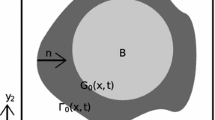Abstract
We have devised a renormalization scheme which allows very fast determination of preferential flow-paths and of up-scaled permeabilities of 2D heterogeneous porous media. In the case of 2D log-normal and isotropically distributed permeability-fields, the resulting equivalent permeabilities are very close to the geometric mean, which is in good agreement with a rigorous result of Matheron. It is also found to work well for geostatistically anisotropic media when comparing the resulting equivalent permeabilities with a direct solution of the finite-difference equations. The method works exactly as King's does, although the renormalization scheme was modified to obtain tensorial equivalent permeabilities using periodic boundary conditions for the pressure gradient. To obtain an estimation of the local fluxes, the basic idea is that if at each renormalization iteration all the intermediate renormalized permeabilities are stored in memory, we are able to compute -- ad reversum -- an approximation of the small-scale flux map under a given macroscopic pressure gradient. The method is very rapid as it involves a number of calculations that vary linearly with the number of elementary grid blocks. In this sense, the renormalization algorithm can be viewed as a rapid approximate pressure solver. The ‘exact’ reference flow-rate map (for the finite-difference algorithm) was computed using a classical linear system inversion. It can be shown that the preferential flow paths are well detected by the approximate method, although errors may occur in the local flow direction.
Similar content being viewed by others
References
Charlaix, E., Guyon, E. and Roux, S.: 1987, Permeability of a random array of fractures of widely varying apertures, Transport in Porous Media 2, 31–43.
Deutsh, C. and Journel, A.: 1992, GSLIB: Geostatistical Software Library and User's Guide, Oxford University Press, New York.
Duquerroix, J. P. et al.: Influence of the permeability anisotropy ratio on large-scale properties of heterogeneous reservoirs, SPE 26612, 28th SPE Ann. Tech. Conf. Exh., Oct. 1993.
Durlofsky, L. J.: 1991, Numerical calculation of equivalent grid block permeability tensors for heterogeneous porous media, Water Resour. Res. 27, 699–708.
King, P.: 1989, The use of renormalization for calculating effective permeability, Transport in Porous Media 4, 37–58.
Mantoglou, A. and Wilson, J. L.: 1982, The turning bands method for simulation of random fields using line generation by a spectral method, Water Resour. Res. 18(5), 1379–1394.
Matheron, G.: 1966, Structure et composition des perméabilités, Revue Inst. Français Pétrole XXI(4), 564–582.
Romeu, R. K. and Noetinger, B.: 1994. Calculation of internodal transmissivities in finite difference models of flows in heterogeneous porous media, Water Resour. Res. 31(4), 943–959.
Stauffer, D.: 1979, Scaling properties of percolation clusters, Phys. Rep. 54, 1.
Zimmermann, D. A. and Wilson, J. L.: Description of and user's manual for TUBA: a computer code for generating two-dimensionnal random fields via the turning bands method, SeaSoft, New Mexico, 1990.
Author information
Authors and Affiliations
Rights and permissions
About this article
Cite this article
Gautier, Y., Nœtinger, B. Preferential Flow-Paths Detection for Heterogeneous Reservoirs Using a New Renormalization Technique. Transport in Porous Media 26, 1–23 (1997). https://doi.org/10.1023/A:1006515616347
Issue Date:
DOI: https://doi.org/10.1023/A:1006515616347




